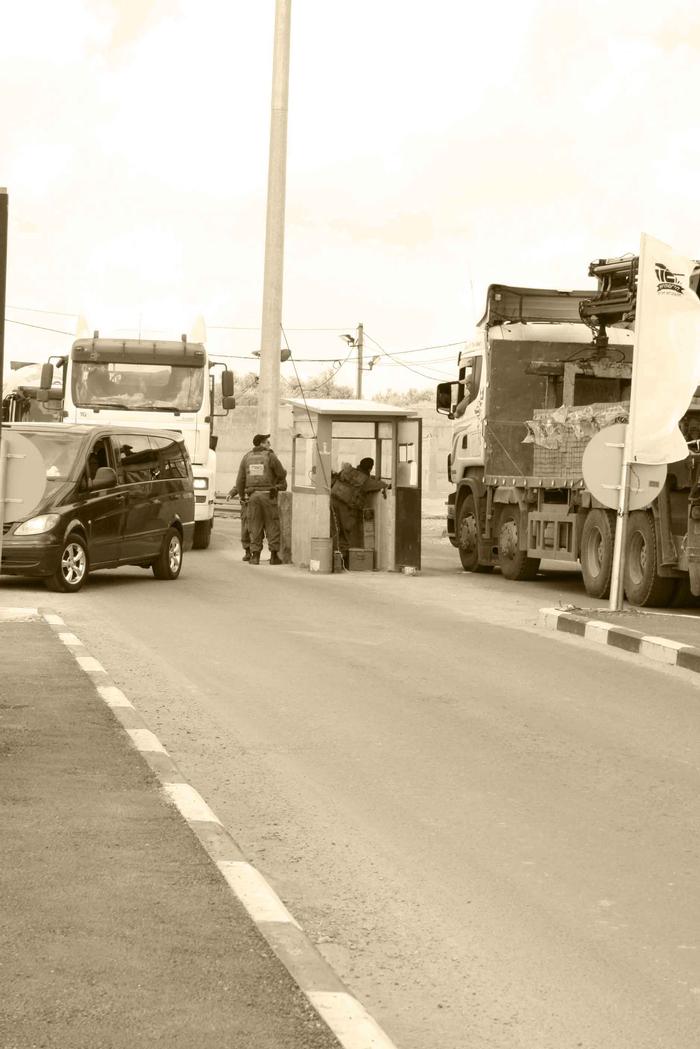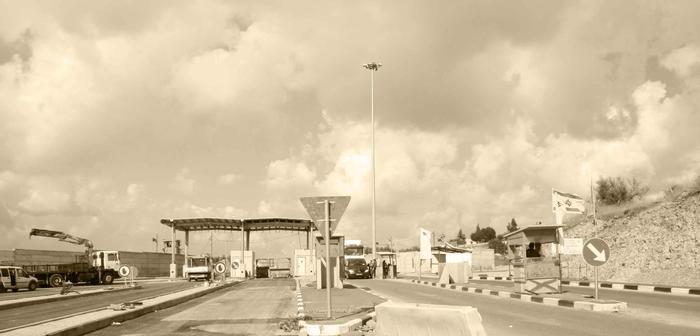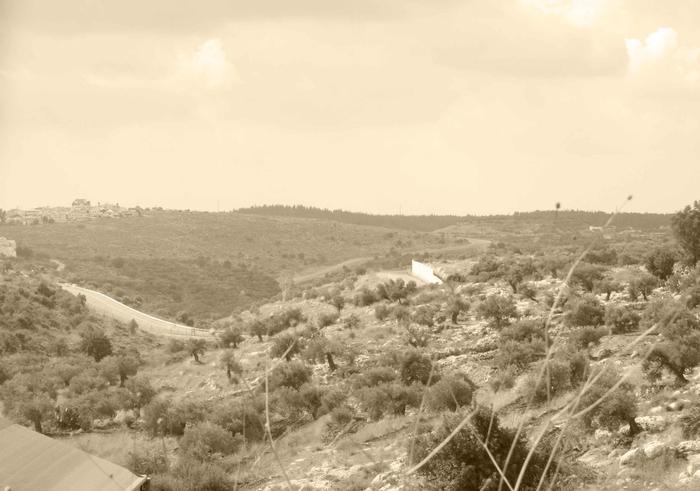[ID:61] A Separate PlaceIsrael On my way to university, I travel through the scenic hills of Judea and Samaria. I know the hills well, from a distance; a familiar place, from afar. It is only at the checkpoint on Road 446 that the far comes close. It is only here that the ‘other’ has a face. It is at this junction that the potential for the sacred becomes apparent. [Image 1 – small checkpoint booth]
Once we have slowed down to join the line of cars waiting to pass the checkpoint, a contemplative quiet descends upon the car. A quiet of thoughts. A quiet of a few slow minutes of actually being a part of the scenery, a sense of the place, missed in the rush of commuting. This place is a checkpoint along the 446, located between the Arab village of Na’alin and the Israeli city of Modi’in Ilit. The checkpoint monitors, via the army, who may enter Israel from the army-governed territory of Judea and Samaria (the West Bank of the Jordan River).
At first glance, it may seem insensitive to call such a place sacred, however by looking deeper into the meaning of the place, the people and the land, I hope to enable you to see the checkpoint in a different light.
The etymology of the word ‘sacred’ in both languages of the Peoples in conflict, can shed light on the sanctity of this place. In Hebrew ‘sacred’ is kadosh, meaning separate and distinct, unlike other secular things. Kadosh can also mean forbidden. In this way, sacred is ambiguous. A separation can be either good or bad. For example, the biblical usage of the word kdesha, meaning prostitute, often referring to the specific worship of ancient gods/idols through sexual relations with these women whom have been set aside for this purpose. Though Kdesha and kadosh (k-d-sh) have the same root, they seemingly have disjointed meanings. However, the kdesha can also be viewed as a woman who has separated herself for a certain purpose, be that considered good or bad. In Arabic the word sacred is of the same origin, mokaddas (or haraam) which can also mean forbidden as well as sacred. This seeming contradiction inherent in the word sacred, found in both Hebrew and Arabic, also applies to the sacred place about which I have chosen to write.
A sacred place is what people make of it. It is a place separated. This sacred site has the potential to be ugly an ugly place or a place of beauty. An exchange of smiles or a nod of the head between Peoples can sanctify this checkpoint and turn it into a place separated from the daily grind, but sanctified with recognition. Conversely, the muted violence of a finger or the abrupt shout of an expletive, transforms the place entirely. It can be a place of tense exiting and entering from one territory to another, void of human association. Or it can be a place of calm passage, where the human connection overcomes the political turmoil.
This sacred place can be a passage of contemplation for all who pass through, be they Israeli Jews, Israeli Arabs, Palestinians, Soldiers or the seemingly unconnected visitor. It is one part of the Arab-Israeli conflict in a nutshell. Like the word sacred itself, the checkpoint can be seen from two seemingly contradictory perspectives. It can be seen as a refuge from the pressures of everyday life, in seeing the occasional triumph of small human gestures over the unending political chaos. Or it can be seen as the opposite, as both a cause and burden to the stresses of the daily grind, specifically to those whose livelihoods depend on being able to cross over.
The sanctity of the checkpoint reflects a state of mind. How do we approach this crossing? With ambivalence? With hope, that this is truly a temporary border present only until the conflict is solved? Or with despair, this is just the beginning of another permanent border between enemy brothers/states? Or as another Berlin Wall, erected only to be torn down once sanity reigned again?
As I write now, and as I have been writing and thinking over the past few months, drastic physical changes and building have been taking place on site, at the sacred little checkpoint I pass through twice daily.
A more permanent border and checkpoint have been planned and are being realized today, in the form of the Separation Fence and the transformation of the small checkpoint into an official border-crossing. The intimacy and human connection of the modest, lone checkpoint booth has been overshadowed literally and figuratively by a huge steel structure, a canopy beneath which stand multiple booths and lanes for cars passing beneath. The sense of the small, temporary structure, where the human connection was once able to overcome the political turmoil, has been negated by the permanence of the enormous structure, aloof and void of human touch. [Image 2 – steel structure overshadows checkpoint]
I believe that the construction of the giant steel structure and the encroachment of the Separation Fence in on either side of the crossing, effectively making the border-crossing permanent, serves neither People. In my eyes this destroys the potential for the sacred in this place.
The checkpoint is one of the few places in Israeli society where Arab and Jew must interact. Therefore, we can and must use this as a place of positive interaction, where together we may overcome the conflict, a meeting of neighbours. Due to the religious nature of the conflict, the intervention on site must, in my mind, be of a material, element or symbol which is common to Christianity, Islam and Judaism.
Although there are only two peoples at conflict, there are three religions involved. The Palestinians are Arabs made up of both Moslems and Christians, while the Israelis are mainly Jewish, yet also Moslem and Christian Israeli-Arabs. Therefore, only something common to the Peoples and religions may lead to a resolution of the ambiguity.
In searching for this common symbol, I further investigated the actual site of this checkpoint. The checkpoint, also known as the ‘Nili Pass’ (Nili after the nearby Jewish settlement, Nili, and after the adjacent Arab village, Na’alin) is situated across Wadi Karika. [Image 3 – south-east view of wadi top and checkpoint] The wadi is a dry valley most of the year, but after heavy rainfall, water flows down the wadi’s watercourse and into the Modi’im River, which connects to it at its lowest point. [Image 4 – west view of wadi]
Water being the precious commodity it is in the Middle East, is a common source of angst and value for both Peoples. Water is also used for religious rituals in Christian, Jewish and Moslem communities. In this sacred land, at this specific crossroad, the architectural intervention should be of water.
In understanding the inherent importance of water to two Peoples and three involved religions, a deeper look is required into the rituals for which it is needed.
In Christianity, the importance of water is primarily in baptism. Through the act of being baptized, one is initiated into the Christian Church. The baptism may include one being fully or partially immersed in water, or even simply sprinkled with a few drops of water. The water symbolizes purification, and cleanses one of the Original Sin and indeed all other sins. The New Testament talks of ‘living water’, as a description of religion and belief in God: “…the water that I will give him will become in him a well of water springing up to eternal life.” [John 4:13]
In Judaism too, water is essential in ritual cleansing which refers to both restoring and maintaining purity, and also in being initiated into the religion as a convert. Ritual full body cleansing must be done in what is known as ‘living water’, a natural collection of water, either a lake, a sea, a river or even a collection of rainwater. There are many forms of simpler ritual washing, such as hand-washing done before and after eating bread, before studying holy texts or praying, after sleeping or after touching something impure. These rituals only require an ordinary tap of water.
Islam also ascribes sacred qualities to water, as a life-giving, sustaining and purifying source. Water is said to symbolize God’s benevolence: “He sends down saving rain for them when they have lost all hope and spreads abroad His mercy.” [Quran 25:48] Ablution is an essential part of Islamic prayer ritual when one is required to wash one’s head, hands, arms and feet before praying, five times a day. Hence, every mosque has running water for this purpose. Even the Arabic word for Islamic law, Shari’ah, is closely related to water and reflects its importance. In early Arabic, the word Shari’ah meant, ‘the place from which one descends to water’. Before the arrival of Islam in Arabia, the word Shari’ah referred to a series of rules about water use; “Shir’at al-maa”- the set of laws giving rights to drinking water. Only later did the term incorporate Islamic law whilst retaining the symbolic importance of ‘the path to water’, the source of life.
This intervention, however, should not be solely of symbolic value. Water is too valuable, even for that. Rather it should be of practical use as well.
One often observes people praying by the side of the highway, specifically on the route to and from Jerusalem, The City of Longing, for these three religions. Many of these people require water to cleanse themselves for prayer, be it by simply washing or sprinkling their hands or feet. Water could provide the reason to stop, to pray, to intermingle. I see this intervention as a man-made spring by the side of the highway, where Arabs and Israelis alike stop to drink, fill up their plastic bottles, clean their hands and use it as a place to pause along their journey. Respectfully, without friction each will await his/her turn for the precious stuff.
I envision one driving across the single-laned asphalt highway, with the gentle sloping hills of Judea and Samaria on either side, patch-worked with squares of olive tree groves, neat red tile roofed settlements and the scenic haphazard building of the villages. As one approaches the small rickety checkpoint booth, one slows down and only now, about 100 meters before the checkpoint, does one notice the wide, low modern wall by the side of the road.
The wall, about one meter high, runs alongside the road with a barely perceptible slope downwards toward the checkpoint. As the low wall reaches the checkpoint, it breaks suddenly, opening into a pool of water several meters wide and then slowly slopes downwards at the other end, for another 100 meters. As we roll to a stop at the checkpoint, we can hear the stream of water as its constant trickle flows through a fissure, cut cleanly into the top of the prefabricated light grey, modern concrete wall. The thin water channel cut into the top of the wall runs all along its length. Where the break in the wall occurs, the channel from each wall face allows for water to cascade down into a pool by the side of the checkpoint. We greet the soldier, who might ask to view our identification papers or work permits, or open and check the boot of the car. We wait, we share a smile and are waved on. As we slowly accelerate, leaving the checkpoint, the sound of running water becomes faint and disappears. The constant stream of water flowing along the channels and into the pool, are sourced at a reservoir collecting rainwater on site and from Wadi Karika’s few annual days of flow.
On either side of the checkpoint, at the beginning base of the wall, are modern concrete niches, with multiple taps, coming out of the niche walls, with no basin, pouring directly into the channel, so as to allow for the washing of feet as well as hands, and the filling up of larger or smaller bottles, etc. These thin water courses, recall the spiritual calm of the slits of water in the courtyards of both Louis Kahn’s Salk Institute in La Jolla and Ram and Ada Carmi’s Supreme Court of Justice in Jerusalem.
The bands of water, pointing both north and south of the border crossing, mark the triumph of the common needs and mutual values and respect of water, religion and the everyday person over all else. The water channels springing from within the Karika Wadi, the land itself, burst past the attempts at confining and marking forced borders upon the land and the Peoples.
I believe that these water channels, both practical and symbolic, preserve the unique sanctity of this crossing as a meeting place between religions and peoples. I believe that the preservation of the small rickety, human checkpoint booth reflects human worth more so than the out of scale, out of touch plans being implemented on site today.
The ambiguity about the etymology of the word ‘sacred’ creates within us objective uncertainty as to what the word actually means. This too is reflected in the ambivalence which sits with us as we approach this place, this checkpoint. However, this ambivalence is a subjective uncertainty. This is something that I hope to overcome, symbolically and practically, with the intervention of water, a common denominator for us all.
Sources used: Even-Shushan Hebrew-Hebrew Dictionary, Volume 5
Sources of Inspiration: Kahn – Salk Institute, La Jolla, California Carmi – Supreme Court of Justice, Jerusalem
If you would like to contact this author, please send a request to info@berkeleyprize.org. |




